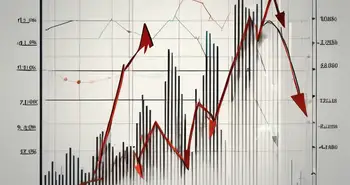Position Trading Explained

Position trading is a popular and effective strategy for traders who are looking to capitalize on long-term market trends. This guide will provide you with a comprehensive understanding of position trading and equip you with the necessary knowledge and skills to develop your own successful strategy.
Understanding Position Trading
Position trading involves holding stocks, commodities, or other financial instruments for an extended period, typically ranging from several weeks to months or even years. Unlike day traders or swing traders who focus on short-term price fluctuations, position traders aim to profit from the broader, long-term trends in the market.
Definition and Basics of Position Trading
In position trading, traders analyze fundamental and technical factors to identify assets with strong growth potential or positioning for a long-term rise in value. The goal is to capture the majority of a significant price move, rather than making quick profits from small price fluctuations.
Position traders often use a combination of research, analysis, and intuition to identify assets with promising long-term prospects. This approach requires patience and discipline, as it may take months for a trade to reach its full potential.
Key Characteristics of Position Trading
One of the key characteristics of position trading is the focus on fundamental analysis. Traders assess macroeconomic trends, industry dynamics, and company-specific factors to identify assets that are undervalued or likely to experience significant growth in the future.
Another important characteristic of position trading is the use of technical analysis. Traders analyze price charts, trends, and patterns to determine the optimal entry and exit points for their trades. Technical indicators, such as moving averages and relative strength index (RSI), are commonly used to assist in the decision-making process.
Position trading is not only about analyzing numbers and charts; it also requires a deep understanding of the market and the factors that drive it. Traders need to keep a close eye on global events, economic indicators, and geopolitical developments that can impact the performance of their chosen assets.
Furthermore, successful position traders often develop a comprehensive trading plan that outlines their entry and exit strategies, risk management techniques, and overall investment goals. This plan serves as a roadmap, helping traders stay focused and disciplined in their decision-making process.
Position trading can be a rewarding strategy for those who have the patience and discipline to stick with it. By focusing on long-term trends and carefully analyzing both fundamental and technical factors, position traders aim to capture significant price moves and generate substantial profits over time.
The Role of Fundamental Analysis in Position Trading
Fundamental analysis is a crucial aspect of position trading. By evaluating economic indicators, market trends, and financial reports, traders can make informed decisions about the potential growth prospects of an asset.
Importance of Economic Indicators
Economic indicators, such as GDP growth, inflation rates, and employment data, provide valuable insights into the overall health of an economy. Position traders carefully monitor these indicators to identify sectors or industries that are likely to outperform in the long run. For example, if economic indicators suggest that consumer spending is increasing, position traders may consider investing in retail or consumer goods companies.
Interpreting Financial Reports
Financial reports, including earnings releases and balance sheets, provide detailed information about a company's financial health. Position traders analyze these reports to assess a company's profitability, debt levels, and growth potential. By identifying companies with strong financial fundamentals, position traders can position themselves to profit from long-term price appreciation.
Technical Analysis for Position Trading
While fundamental analysis plays a significant role in position trading, technical analysis also provides valuable insights into the market. By analyzing price charts and using technical indicators, traders can identify entry and exit points for their trades.
Chart Patterns and Trends
Chart patterns, such as support and resistance levels, trendlines, and chart formations, can provide important clues about future price movements. Position traders look for patterns that indicate a potential trend reversal or continuation, allowing them to enter or exit a trade at the optimal time.
Technical Indicators to Consider
Technical indicators, such as moving averages, MACD (Moving Average Convergence Divergence), and Bollinger Bands, can help position traders confirm trends and identify potential trade opportunities. These indicators provide insights into market momentum, overbought or oversold conditions, and trend strength, assisting traders in making informed trading decisions.
Risk Management in Position Trading
Effective risk management is crucial in position trading to protect your capital and minimize losses. Position traders employ various risk management techniques to ensure that their trades have an appropriate risk-reward ratio.
Setting Stop Loss and Take Profit Levels
A stop loss order is an essential tool for position traders to limit potential losses. By setting a stop loss level, traders can automatically exit a trade if the price moves against them beyond a predetermined threshold. On the other hand, setting a take profit level allows traders to secure profits once the price reaches their target.
Importance of Diversification
Diversification is another critical aspect of risk management in position trading. By spreading investments across different asset classes, industries, or regions, traders can reduce the impact of individual asset performance on their overall portfolio. Diversification helps protect against excessive losses and increases the potential for long-term gains.
Developing a Position Trading Strategy
Creating a well-defined and effective position trading strategy is key to long-term success in the market. While every trader may have their unique approach, there are some fundamental steps that can guide you in developing your own strategy.
Steps to Create a Successful Strategy
1. Define your investment goals and risk tolerance: Determine what you want to achieve with your position trading and how much risk you are willing to take.
2. Conduct thorough research and analysis: Utilize both fundamental and technical analysis to identify potential investment opportunities.
3. Plan your entry and exit strategy: Determine the criteria for entering and exiting a trade.
4. Implement risk management techniques: Set stop loss and take profit levels to protect your capital.
5. Monitor and review your trades: Regularly evaluate the performance of your trades and adjust your strategy as necessary.
Common Mistakes to Avoid
1. Lack of discipline: Stick to your strategy and avoid impulsive decisions based on emotions or short-term market fluctuations.
2. Overtrading: Focus on quality trades rather than quantity. Taking on too many positions can increase risk and make it difficult to effectively manage your trades.
3. Ignoring risk management: Always prioritize risk management techniques such as stop loss orders and diversification to protect your capital.
4. Failing to adapt: Markets are constantly evolving. Stay updated with relevant news and adjust your strategy accordingly to stay ahead of the curve.
As an experienced position trader, I have witnessed firsthand the power of this strategy. By carefully analyzing both fundamental and technical factors and implementing solid risk management practices, I have been able to consistently achieve substantial profits over the long term. Position trading requires patience and discipline, but the potential rewards are well worth it.
Frequently Asked Questions (FAQ)
What is position trading?
Position trading is a long-term trading strategy in which traders hold assets for an extended period to profit from long-term market trends.
What are the key characteristics of position trading?
Position trading involves a focus on fundamental analysis, the use of technical analysis, and a patient, long-term approach to capturing significant price movements.
How does fundamental analysis play a role in position trading?
Fundamental analysis helps position traders assess economic indicators and financial reports to identify assets with strong growth potential.
What is the role of technical analysis in position trading?
Technical analysis provides insights into price patterns, trends, and market momentum, assisting position traders in identifying optimal entry and exit points.
What is the importance of risk management in position trading?
Effective risk management, including setting stop loss and take profit levels and diversifying investments, helps position traders protect their capital and minimize losses.
What are some common mistakes to avoid in position trading?
Common mistakes to avoid in position trading include lack of discipline, overtrading, ignoring risk management techniques, and failing to adapt to changing market conditions.
Position trading can be a highly rewarding strategy for traders who are committed to long-term success in the market. By combining thorough research, analysis, and risk management, you have the potential to achieve significant profits and build a successful trading career.
Ready to take your position trading to the next level? Discover Morpher.com, the revolutionary trading platform that empowers you to capitalize on market trends with zero fees and infinite liquidity. Whether you're interested in stocks, cryptocurrencies, or even niche markets like NFTs, Morpher's blockchain technology offers fractional investing, short selling without interest fees, and up to 10x leverage to enhance your trading strategy. Experience the safety and control of a non-custodial wallet and the innovation of trading Virtual Futures. Sign Up and Get Your Free Sign Up Bonus today to join the future of investing with Morpher.

Disclaimer: All investments involve risk, and the past performance of a security, industry, sector, market, financial product, trading strategy, or individual’s trading does not guarantee future results or returns. Investors are fully responsible for any investment decisions they make. Such decisions should be based solely on an evaluation of their financial circumstances, investment objectives, risk tolerance, and liquidity needs. This post does not constitute investment advice.

Painless trading for everyone
Hundreds of markets all in one place - Apple, Bitcoin, Gold, Watches, NFTs, Sneakers and so much more.

Painless trading for everyone
Hundreds of markets all in one place - Apple, Bitcoin, Gold, Watches, NFTs, Sneakers and so much more.









